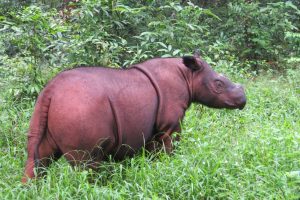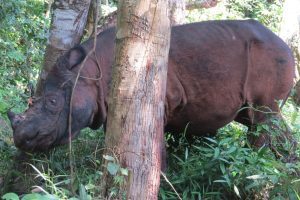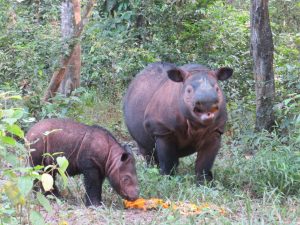The Millenial Generation Inherits the Task of Rescuing Rhinos in Indonesia that Resonates with the Whole World

-
Date:
21 Sep 2021 -
Author:
KEHATI
Written by Haerudin R. Sadjudin
Expert Staff on Large Mammals Conservation;
Indonesia Wildlife and Conservation Foundation-IWF
The world has five types of rhinos, two in Africa (Diceros bicornis and Ceratotherium simum) and three in Asia(Rhinoceros unicornis, Rhinoceros sondaicus and Dicerorhinus sumatrensis). In Indonesia, there are two types: Javan/Sunda Rhinoceros (Rhinoceros sondaicus Desmarest, 1822) and Sumatran Rhinoceros (Dicerorhinus sumatrensisFischer, 1814).
Both of these types of rhinos in Indonesia are not endemic, but relic animals. The spread used to cover many areas, but now the population continues to decrease, and the distribution has become limited. This occurs due to the conversion of forests as the habitat of rhinos; becoming plantations, residential areas, and spatial businesses for various needs. Poaching against rhinos ha a long history as well, causing the loss of their spread in some areas. Even in rhino habitats established as conservation areas, the population continues to decrease in the last 45 years.
The two types of rhinos in Indonesia are categorized by IUCN (International Union of Conservation Nature and Natural Resources) as Critical Endangered Species, the types that are one step away from extinction. Various efforts and attempts have been done to save them. It appears, however, these efforts are not optimal because not all of the potentials and capabilities have been mustered by multi-parties to save rhinos from extinction. No movements from the millennial generation have surfaced to save both of these rhino types from extinction. This is a challenge for Biodiversity Warriors, which consists of millennials, since they are expected to carry out a global revolution movement so that these two rhino types can be saved from extinction. This movement must resonate and shake the world, and shatter the earth to its core.
Rhino Rescue Strategy in Indonesia
The priority program in the Rhino Conservation Strategy in Indonesia document has promoted real actions to save Javan Rhinoceros and Sumatran Rhinoceros from the threat of extinction. This rescue actions are realized in the implementation of programs by the Government of Indonesia; cooperating with various organizations, such as Yayasan Badak Indonesia (YABI), International Rhino Foundation (IRF), World Wide Fund for nature and natural resources (WWF), Wildlife Conservation Society (WCS), Tropical Forest Conservation Action for Sumatera (TFCA-Sumatera, Kehati Foundation), and many more.
Some of the rescue actions include:
- Rhino Protection Unit (RPU), which was established since early 1996, is still active until today in Ujung Kulon National Park/TNUK (4 RPU units), Way Kambas National Park/TNWK (5 RPU units), and Bukit Barisan Selatan National Park/TNBBS (7 RPU units).
- Sumatran Rhino Sanctuary (SRS) carried out in TNWK since 1998, has facilitated the birth of two baby rhinos from the mating of a male rhino (Andalas) and female rhino (Ratu) on June 23, 2012 and May 12, 2016. These baby rhinos are named “Andatu” and “Delilah”.
- Javan Rhino Study and Conservation Area (JRSCA) in TNUK has been implemented since 2010 to expand the habitat of Javan Rhinoceros to a part of Mount Honje in the eastern side of Ujung Kulon peninsula, which is the primary habitat of Javan/Sunda Rhinoceros. Currently there are 5 Javan Rhinoceroses that have been placed into the JRSCA area, after the habitat in this area has been developed and managed.
- Population genetic study in the wild by analyzing rhino droppings has been carried out, in collaboration with PHKA, YABI, WWF and WCS at Ujung Kulon, Way Kambas and Bukit Barisan Selatan. This program is done through the assistance from Eijkmen Institute, which has the equipment, materials, and experts to conduct the analysis. This program needs time to conclude the population structure of the two rhino types in each of these locations.
- TFCA-Sumatera, there were three activity components carried out through the Tropical Forest Conservation Action for Sumatera (TFCA-Sumatera) grant in the landscape of Way Kambas National Park and Bukit Barisan Selatan National Park. These components were done by establishing a Consortium that consists of YABI-WCS-YAPEKA (Yayasan Pendidikan Konservasi Alam or Natural Conservation and Education Foundation), and they were: Component I (Protecting the population and habitat of Sumatran Rhinoceros, implemented by YABI); Component II (Mitigating Conflicts between humans and elephants in Way Kambas and with tigers in Bukit Barisan Selatan, carried out by WCS); Component III (Improving the creative economy and community empowerment, conducted by YAPEKA). These three activity components had been done effectively since May 2013 until April 2016.
- Several other short term activities have been done through various support from both international and domestic donors.
- Fundraising activities, especially the support from national-scale donors, have not been done optimally. It is expected that going forward, the millennial generation can carry out fundraising movements, and movements to rescue both of these rhino types, both in the field and in a semi in-situ
Javan/Sunda Rhinoceros Rescue
Since 1974, when poaching allegedly stopped, until today, 5 Rhino Protection Units are still in operation since 1999. Meanwhile, the second habitat plan for Javan Rhinoceros has been planned since 1993, when the Strategy and Plan for Rhino Conservation Action in Indonesia (SRAK) 1993-2003 was signed by the Minister of Forestry; now the Minister of Environment and Forestry. Then it was continued with SRAK for Rhinos in Indonesia 2007-2017. In the discussion of the latest draft of Javan Rhinoceros SRAK [2019-2029] on January 25, 2019, there was even a proposal to expand the habitat in Ujung Kulon. The first stage emergency action for three years, 2019-2022, is the main part of this SRAK draft.
The habitat of Javan Rhinoceros is currently only located in the Ujung Kulon Peninsula, bordered by Tanah Genting, around two kilometres from the southern coast of Karangranjang to the northern coast of Laban. Ujung Kulon Peninsula is located on the west side of Tanah Genting, while in the eastern part lies lowlands connecting it to the hills of Mount Honje. Some areas of Mount Honje has now become the Javan (Sunda Land) Rhino Study and Conservation Area [JRSCA]. The corridors of Ujung Kulon Peninsula include; Cibandawoh-Karangranjang to Mount Honje; and Kalejetan-Aermokla. There are only five rhinos whose exploration reaches these areas.
The habitat expansion in Mount Honje area needs to be conditioned from JRSCA on the western part of Cihujan-Cilintang to Cimahi-Cibiuk, the eastern area of Mount Honje. If the total JRSCA area is around 5,000 hectares, plus the habitat expansion of around 5,000 hectares; there will be a second population pocket in the natural habitat of 10,000 hectares. This habitat expansion cannot be called a second habitat. The second habitat of Javan Rhinoceros needs to be established outside of Ujung Kulon. Determining the second habitat location for Javan Rhinoceros needs to be done immediately. At this time, only 60 percent of Ujung Kulon Peninsula are used as rhino spread areas. The rest, the hills of Mount Payung in the western side and the central part of Mount Kendeng, are not used as exploration territories. However, it is not easy to obtain a second habitat for Javan Rhinoceros like their original habitat in Ujung Kulon.
Criteria of the second habitat of Javan Rhinoceros:
- Comfortable and suitable to their living behaviour.
- Easy access for long term management.
- Free from poaching and habitat damage.
- Far from disaster locations like tsunami (not on the coast), earthquake (not near a fault line), volcano eruption (not near an active volcano), and landslide (not placed on a hill).
- Diverse vegetations, especially high feed types.
Besides technical planning, sufficient funding is crucial to rescue Javan Rhinoceros. Of course accompanied by a strong commitment from all parties. Without real actions, it is the same as letting Javan Rhinos go extinct, despite numerous strategies that have been prepared.
Sumatran Rhinoceros Rescue
The critical Sumatran Rhinoceroses only live in three Sumatran landscapes and one area outside of the conservation area in East Kalimantan. The decreasing number of Sumatran Rhinos are no longer only caused by poaching and habitat constriction, but also the small population living scattered from one another. An important issue that needs to be resolved at this very moment is the actual population of Sumatran Rhinos, which even though not certain, it is believed to be no more than 100 individuals across their spread locations.
 |
 |
Andatu-left& Andalas-right, the male that gave way to the first birth, Andatu, on June 23, 2021, as the last future generation of Sumatran Rhinos at the Way Kambas National Park
Photo: Haerudin R. Sadjudin, TFCA-Sumatera Program & YABI 2013-2016
Emergency actions to save Sumatran Rhinos must immediately be implemented, referring to the Emergency Action Plan (RAD) for Sumatran Rhino Conservation set forth by the Directorate General of KSDAE, KLHK, Number: SK. 421/KSDAE/SET/KSA.2/12/2018.
During the development of the Strategy and Action Plan (SRAK) for Rhinos in Indonesia 1993-2003, the number of rhinos in Sumatra was estimated to be 400-800 individuals, in 1990. At that time, researchers believed that these two horned animals was still living at Mount Leuser, Kerinci Seblat, Bukit Barisan Selatan, and Way Kambas.
The Sumatran rhino population continues to decline. The current population is believed to not be more than 100 individuals. This population decrease is not only caused by poaching and habitat constricting, but also small number of population living scattered from each other.
In the northern part of Kerinci Seblat National Park, South Bengkulu area, in 1995 there was an estimation of 10 rhinos. But Sumatran Rhinos in the area now is believed to have been extinct since 2011.
Sadjudin, 2017, in his book “Sumatran Conservation Beat” or “Detak Konservasi Sumatra” wrote that in 1955, Boeadi, a researcher from LIPI, managed to capture 12 rhinos in Giam Siak Bukit Batu, Riau, within 1.5 years. Nine of them were released back to the wild, one died in the forest, and two were brought to the Bogor Wildlife Garden. However, both of them died after no more than three months there. The skeletons were kept in the Zoology Museum, Bogor.

Photo: Haerudin R. Sadjudin, TFCA-Sumatera Program & YABI 2013-2016
In TNBBS, since 2012, WWF-Indonesia has installed camera traps. In 2015, two rhinos were found and captured by these cameras. Meanwhile, the finding from TNBBS RPU, from various sizes of prints and different and far apart locations, the population is estimated to be around 17-24 individuals (expert meeting at Gisting, 2016). Both national and international experts agreed to immediately translocate rhinos in TNBBS to TNWK.
Based on the Population Viability Analysis Workshop [2015], there are 31-36 sumatran rhinos in TNWK, plus an additional baby rhino born in the wild on August 2016 (RPU-Way Kambas, 2016). Therefore, Sadjudin (2017) in the “Sumatran Conservation Beat” predicted that TNWK will be the last fortress of Sumatran rhinos in the world. Way Kambas is their last hope because of its effective and maximum protection, and the existence of Sumatran Rhino Sanctuary, which has facilitated the birth of two baby rhinos.
All of these population estimations are just that, estimations. Unlike Javan Rhinos at Ujung Kulon, in which the population estimation using camera traps is close to the actual number. Javan Rhinos are located in a narrow lowland forest habitat at the Ujung Kulon Peninsula, and they are easier to differentiate from one individual to another. This was found after 10 years of installing camera traps. Thus, we no longer have to deal with calculating Sumatran Rhinos in Sumatra or Kalimantan. The most important thing is the emergency action that must be done immediately. The effective protection of Sumatran Rhinos in TNWK aims to save their population not only in the wild, but also rhinos in SRS (Sumatran Rhino Sanctuary).
Rescuing the population of Sumatran Rhinos is a serious issue. Therefore a document was developed. This document is called the Emergency Action Plan [RAD] stipulated by the Directorate General of Natural Resources and Ecosystem Conservation [Ditjen KSDAE] of the Ministry of Environment and Forestry. The focuses that must be emphasized are:
- Consolidating the population of Sumatran Rhinos located within the Leuser Ecosystem Area and Mount Leuser National Park to a habitat that has a total area of more than 100,000 hectares.
- Tracking the existence of rhinos in TNBBS, identifying, capturing, and translocating them to SRS, TNWK. In addition, if in the next year or two TNBBS has built an SRS just like in TNWK, it will be better to send rhinos that are ready to be released into the wild at SRS, Way Kambas, to the SRS at Bukit Barisan Selatan. This is because we have to also prepare TNBBS as the second habitat for Sumatran Rhinos located in Lampung.
- With the birth of two baby rhinos at SRS, Way Kambas, making it a total of 7 individual rhinos, there needs to be genetic diversity enrichment and expansion of SRS by 120 hectares. Therefore, the effective protection for rhinos both in the wild and in SRS must be increased.
- The Sumatran Rhinos in East Kalimantan must be tracked down and captured to be rescued in the SRS at Kelian Lestari Protected Forest. Currently there is one male rhino, Pahu, who was saved from HPH forest in West Kutai.
- Potential available funding, both from TFCA-Sumatera Program and other donors need to be refocused on rescuing rhinos through the Emergency Action Plan for Sumatran Rhino Conservation in Sumatera and Kalimantan.
Can the Millennial Generation Come to the Rescue?
Both the population and area of spread of Javan and Sumatran Rhinos are currently very small and limited. Both of these rhino types are still threatened from poaching and loss of habitat as their place to live in the wild. This very small population will be very sensitive to natural disasters, genetic weaknesses, and demographics. Thus there is a need for a movement from the youths, the millennial generation, to rescue them; by combining the militancy spirit on the field and genetic engineering technology that is beginning to be implemented in developed countries, like in Germany for African Rhinoceros.

Photo: Haerudin R. Sadjudin, TFCA-Sumatera Program dan YABI
Therefore; we need a movement from the millennial generation who can carry out swift and real actions, both for fundraising and real actions on the ground. In 2021, The World Rhino Day, which is commemorated every September 22, must serve as a driver for a revolutionary movement by the millennial generation to save these two rhino types in Indonesia from further threats of extinction.
This Revolutionary Movement to Save Rhinos in Indonesia needs to be done by the millennial generation in general, specifically by the Biodiversity Warrior (BW), which has become the flagship program of the Indonesian Biodiversity Foundation or Yayasan Keanekaragaman Hayati Indonesia (KEHATI). This program includes members consisting of militant youth, and campaigns about saving biodiversity from the threat of extinction; using social media. It echoes across the nation, and can even move the hearts of millennial generations around the world.
Bibliography
Sadjudin, H. R. 2021. Strategi Penyelamatan Badak; in Metode Dan Kajian Konservasi Biodiversitas Indonesia; pp.655-660 (Edt. Jatna Supriatna). Yayasan Pustaka Obor Indonesia. Jakarta.
Sadjudin, H.R. 2019. Tindakan Darurat Penyelamatan Badak Sumatera Harus Dilakukan. www.mongabay.co.id.
Sadjudin, H.R. 2019. Kepunahan Badak Sumatera, Mata Dunia Kini Tertuju Ke Indonesia. www.mongabay.co.id.
Sadjudin. H. R. 2019. Mewaspadai Kematian Badak Jawa Di Ujungkulon. www.mongabay.co.id.
Sadjudin, H. R. 2019. Habitat Badak Jawa, Adakah Yang Seideal Ujung Kulon? www.mongabay.co.id.
Sadjudin, H. R. 2018. Yayasan Badak Indonesia (YABI); in Langgam Salindia Kisah Lapangan Pelaku Konservasi Sumatera, pp.11-21 (Edt. Safrizaldi Jpang). Pundi Sumatera (Central and South Facilitator of TFCA-Sumatera).
Sadjudin, H.R. 2018. Terancam Punah, Haruskah Badak Jawa Bertahan Di Ujung Kulon? Konservasi Badak Sumatera Berbasis Masyarakat Di Taman Nasional Way Kambas, www.mongabay.co.id.
Sadjudin, H.R. 2018. Jangan Pernah Menyerah, Menyelamatkan Badak Sumatera Di Kalimantan Timur. www.mongabay.co.id.
Sadjudin, H.R. 2017. Way Kambas, Benteng Terakhir Badak Sumatra; in Detak Konservasi Sumatra, pp.158-170 (ed.Syaffrizaldi Jpang). PT Gramedia Pustaka Utama, Jakarta.
Sadjudin, H.R. 2015. Lestarikan! Dua Jenis Badak Ini Sudah Diambang Kepunahan. www.mongabay.co.id.
Sadjudin, H. R. 1999. Program Konservasi Badak Sumatera (Dicerorhinus sumatrensis Fischer, 1814) di Taman Nasional Way Kambas, Lampung Tengah, pp.44-53; in the Proceeding of the Seminar and Workshop on Community-based Sumatran Rhino Conservation at Way Kambas National Park. Bandar Lampung, 13-14 November 1999.
